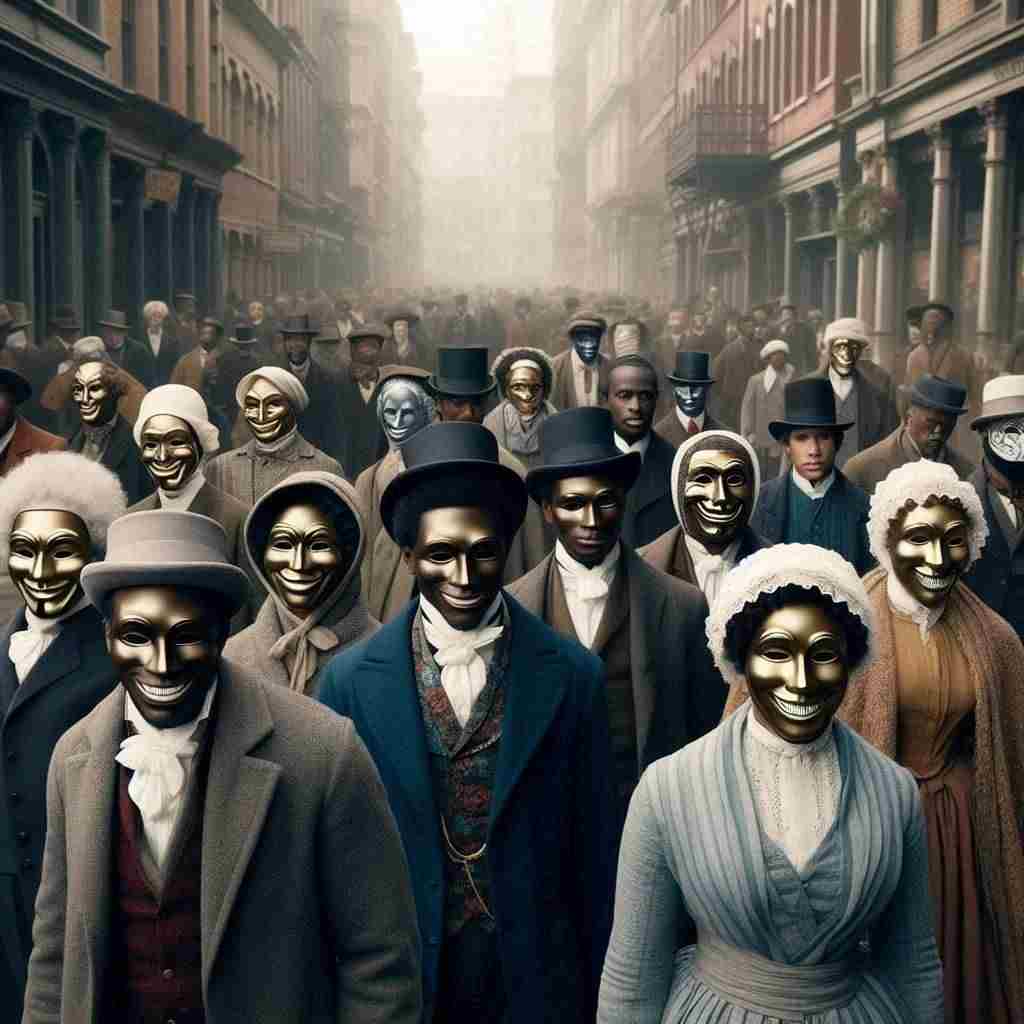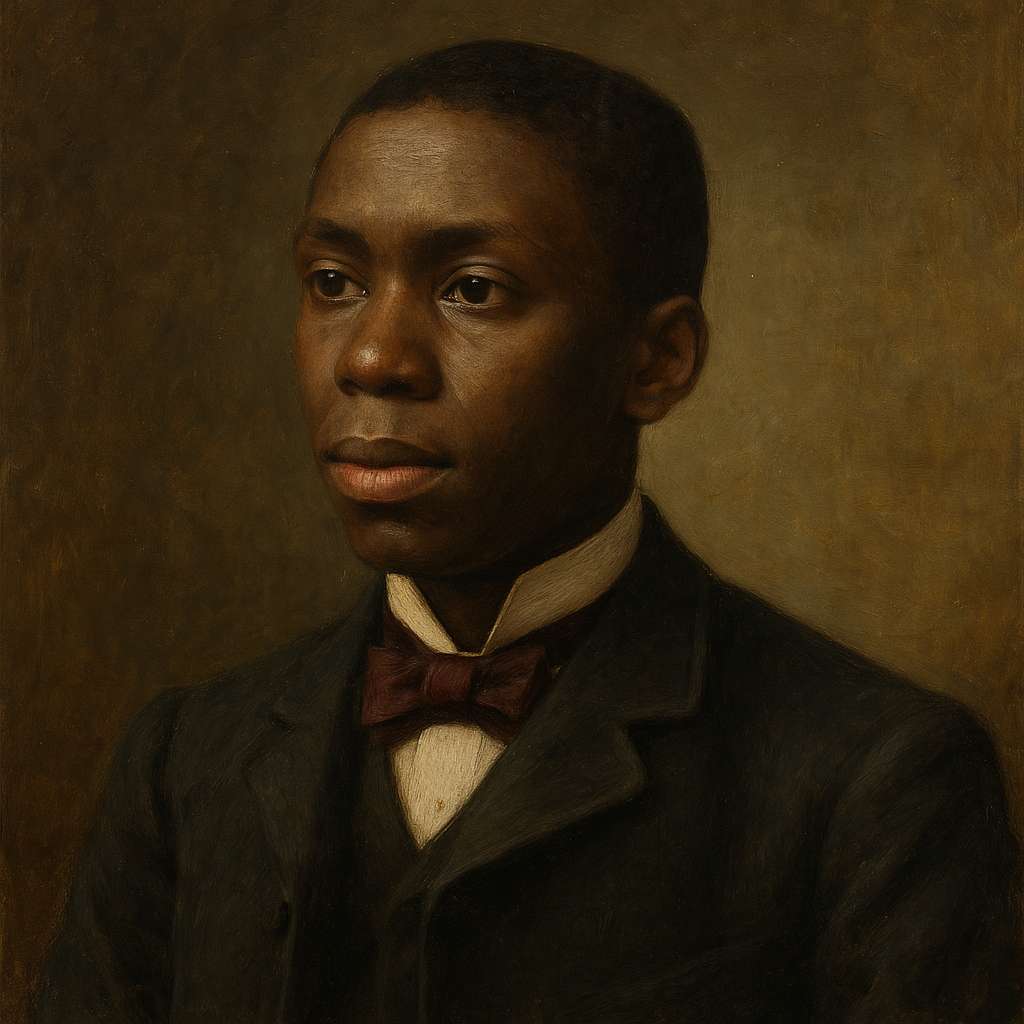We Wear the Mask
Paul Laurence Dunbar
1872 to 1906

Want to track your favorites? Reopen or create a unique username. No personal details are required!
We wear the mask that grins and lies,
It hides our cheeks and shades our eyes,—
This debt we pay to human guile;
With torn and bleeding hearts we smile,
And mouth with myriad subtleties.
Why should the world be over-wise,
In counting all our tears and sighs?
Nay, let them only see us, while
We wear the mask.
We smile, but, O great Christ, our cries
To thee from tortured souls arise.
We sing, but oh the clay is vile
Beneath our feet, and long the mile;
But let the world dream otherwise,
We wear the mask!
Paul Laurence Dunbar's We Wear the Mask
Introduction
Paul Laurence Dunbar's poem "We Wear the Mask" stands as a poignant exploration of the African American experience in post-Civil War America. Published in 1896, this work encapsulates the complex psychological and social dynamics of a people navigating a society still deeply entrenched in racial prejudice and discrimination. Through its masterful use of imagery, rhythm, and metaphor, Dunbar's poem illuminates the dichotomy between outward appearance and inner turmoil, shedding light on the survival strategies employed by African Americans in the face of persistent oppression.
Historical Context
To fully appreciate the depth and significance of "We Wear the Mask," one must first understand the historical context in which it was written. Dunbar, born to former slaves in 1872, came of age during the Reconstruction era and its aftermath. This period, while ostensibly offering newfound freedoms to African Americans, was marked by the rise of Jim Crow laws, widespread racial violence, and systemic disenfranchisement. Against this backdrop, Dunbar's poem emerges not merely as a personal lament but as a collective voice articulating the shared experience of a community forced to navigate a hostile social landscape.
Structural Analysis
The poem's structure is deceptively simple, consisting of fifteen lines arranged in three stanzas - two quintains (five-line stanzas) bookending a quatrain (four-line stanza). This form, reminiscent of the rondeau, a French poetic form, allows Dunbar to create a circular narrative that reinforces the pervasive nature of the "mask" metaphor. The repetition of the phrase "We wear the mask" at the beginning and end of the poem serves to emphasize the inescapable nature of this social performance.
Dunbar's use of rhyme scheme (AABBA in the first and third stanzas, and AAAB in the second) creates a musical quality that belies the poem's somber content. This juxtaposition of form and content mirrors the very duality the poem describes - a cheerful exterior concealing deep-seated pain.
Metaphorical Depth
Central to the poem is the extended metaphor of the mask. This powerful image serves multiple functions within the text. Primarily, it represents the facade of contentment and subservience that African Americans were often forced to adopt in their interactions with white society. The mask "grins and lies," presenting a false face to the world while concealing the true emotions and experiences of those who wear it.
The mask also functions as a symbol of protection. By hiding "our cheeks" and shading "our eyes," it shields the wearer from the full brunt of society's scrutiny and judgment. However, this protection comes at a significant cost, as evidenced by the "torn and bleeding hearts" that lie beneath the smiling exterior.
Furthermore, the mask can be interpreted as a critique of white society's willful ignorance. The rhetorical question "Why should the world be over-wise, / In counting all our tears and sighs?" suggests a complicity on the part of the dominant culture in maintaining this facade, preferring to see only the mask rather than confront the reality it conceals.
Language and Tone
Dunbar's choice of language throughout the poem is both evocative and precise. The use of words like "guile," "subtleties," and "over-wise" creates a tone of bitter irony, highlighting the intellectual and emotional complexity of the mask-wearing experience. This sophisticated vocabulary stands in stark contrast to the dialect poetry for which Dunbar was primarily known, perhaps serving as a deliberate choice to subvert expectations and assert the poet's mastery of "standard" English.
The shift in tone between the first two stanzas and the final one is particularly noteworthy. While the earlier lines maintain a certain detachment, describing the mask-wearing phenomenon in general terms, the last stanza introduces a raw emotionality with its direct address to "O great Christ." This invocation of the divine not only adds a spiritual dimension to the poem but also serves to emphasize the depth of suffering experienced by the speakers.
Collective Voice and Universal Themes
One of the most striking aspects of "We Wear the Mask" is its use of the collective "we." This choice of pronoun transforms the poem from an individual lament into a communal expression of shared experience. The "we" encompasses not just the poet but an entire people, united in their struggle and their strategies for survival.
While the poem is deeply rooted in the specific experience of African Americans in the late 19th century, its themes of hidden suffering, forced performance, and the disparity between public and private selves resonate far beyond its immediate context. This universality has contributed to the poem's enduring relevance, allowing readers from various backgrounds and historical moments to find echoes of their own experiences in Dunbar's words.
Imagery and Sensory Details
Dunbar's skillful use of imagery brings the abstract concept of the mask vividly to life. The image of "torn and bleeding hearts" contrasted with smiling faces creates a visceral sense of the pain involved in maintaining the facade. The phrase "mouth with myriad subtleties" evokes the complex and nuanced nature of this performance, suggesting layers of meaning behind every word and gesture.
In the final stanza, the introduction of more concrete, earthbound imagery - "the clay is vile / Beneath our feet, and long the mile" - grounds the poem's metaphorical conceits in physical reality. This shift emphasizes the tangible, day-to-day struggle of living under oppression, moving beyond the metaphor of the mask to touch on the broader conditions of African American life.
Rhythm and Sound
The poem's rhythmic structure, with its regular iambic tetrameter punctuated by moments of variation, creates a sense of relentless forward motion. This rhythm can be read as mimicking the continuous nature of the mask-wearing experience - a never-ending performance with no respite.
Dunbar's use of alliteration and assonance throughout the poem ("grins and lies," "torn and bleeding hearts," "myriad subtleties") adds to its musicality and emotional impact. These sound patterns create a hypnotic effect, drawing the reader into the poem's world and reinforcing its central themes.
Intertextuality and Literary Tradition
"We Wear the Mask" can be situated within a broader tradition of African American literature that explores themes of double consciousness and hidden identity. The poem's concerns echo those articulated by W.E.B. Du Bois in his concept of "double consciousness," which describes the experience of always viewing oneself through the eyes of others.
Moreover, the poem's use of Christian imagery and its appeal to divine understanding place it within a long tradition of African American spiritual expression. The cry to "O great Christ" evokes the spirituals and gospel traditions, linking personal suffering to a larger framework of religious meaning and potential redemption.
Conclusion
Paul Laurence Dunbar's "We Wear the Mask" stands as a testament to the power of poetry to articulate complex social and psychological realities. Through its deft use of metaphor, structure, and collective voice, the poem offers a profound meditation on the experience of marginalization and the strategies employed to navigate hostile social environments.
The enduring relevance of "We Wear the Mask" lies not only in its historical significance but in its ability to speak to universal human experiences of concealment, performance, and the search for authentic self-expression. As we continue to grapple with issues of identity, social justice, and the legacy of historical oppression, Dunbar's words remain a powerful reminder of the human cost of systemic inequality and the resilience of those who bear its weight.
In its final lines, the poem leaves us with a haunting image of a world content to "dream otherwise," willfully ignorant of the suffering behind the mask. This challenge to complacency continues to resonate, urging readers to look beyond surfaces and confront the complex realities that lie beneath our social facades. In doing so, "We Wear the Mask" not only illuminates a specific historical moment but also provides a lens through which we can examine our own society and the masks we all wear.
This text was generated by AI and is for reference only. Learn more
Want to join the discussion? Reopen or create a unique username to comment. No personal details required!



Comments
No comments yet. Be the first to comment!